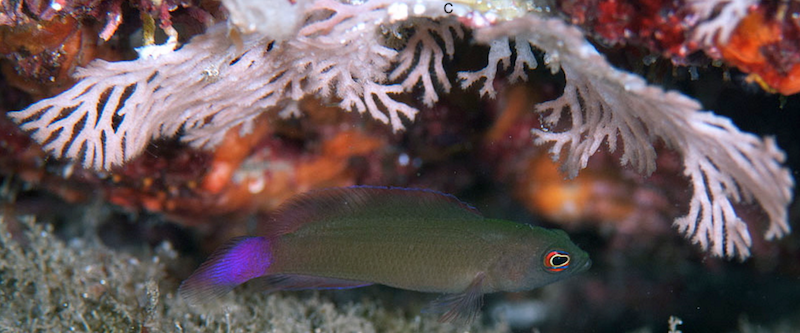
There are many many dottyback species out there but only a very small fraction of them show up in the trade. An even smaller fraction that do not show up in the trade are virtually unknown with hardly any information and pictures available on them. One such species is Pseudochromis luteus. Continue reading for more awesome pictures of this really pretty dottyback.

Males of Pseudochromis luteus are a brilliant orangey-pink and yellow overall with no landmark patterns or designs. Unlike other dottybacks, the generally lackluster appearance of the female in this species is made up with that insanely brilliant purple-pink tail. The general body color aside from the tail is a greenish-grey. This characteristic of a grey body coupled with a different colored tail can be seen in other dottyback species such as the females of P. coccinicauda and P. tapeinosoma.
The females of both species are greyish overall with the former having an orange-red tail and the latter having a yellow tail. It is unfortunate that the highly aggressive nature of dottybacks will probably not allow the mixing of all three species in the same tank. It’ll be curious and interesting to have the females of P. tapeinosoma, P. coccinicauda and P. luteus all in the same tank. A fun mixture of yellow, orange and purple tails painted on grey toned dottybacks. Even if dottybacks were angels, which they are not, P. luteus would be a stretch to obtain.

The males resemble the Cypho dottybacks a little, especially Cypho zaps. Again, that brilliant orangey-pink and yellow is outstanding and eye catching for a little dottyback. A pair of these would certainly brighten up any reef tank and believe me, dottyback lovers and breeders would definitely want some of these for their next breeding project.

As mentioned before, P. luteus is difficult to obtain not because it is rare in the wild, but its a species that has not been collected for the aquarium trade. Pseudochromis luteus is mainly found in Japan and at depths of 5-10m. It is also reported to be found in the Philippines but all pictures and information available for this species so far are based on individuals found in Japan and none being documented from the Philippines. That doesn’t mean that it’s a Japanese endemic though as most Japanese fishes end up documented in the Philippines as well.

We really hope to see this fish end up in the aquarium trade one day. With so many successful breeding projects going on with dottybacks, this would be a perfect addition to the repertoire. Nothing beats the orange and purple couple combination of P. luteus.



